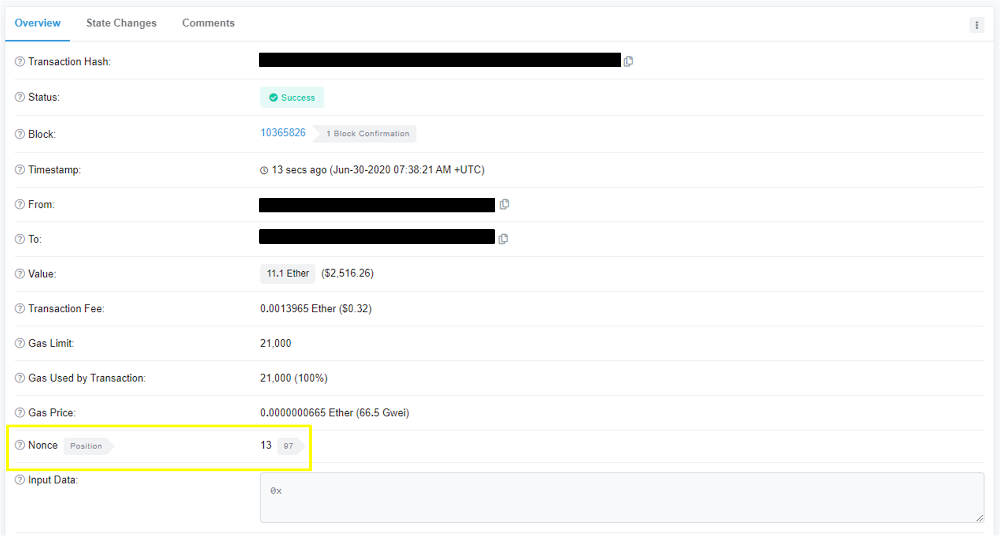What happens when a Dropped Transaction is replaced by another Transaction?
To answer the question, we must first touch on a parameter in an Ethereum transaction called the nonce.
A nonce indicates the number of transactions that have been sent by an address. It starts with the number 0 and so the first outgoing transaction of an address will always have a nonce value of 0. With every transaction, the nonce value increases by one. As an example, if an address has previously sent two transactions and is going to send a third one, the new transaction will have a nonce value of 2. This is because the first transaction was 0, and the one after that was 1.
From the points mentioned above, we can conclude that there can never be be two transactions, or more, from the same address with the same nonce value because the nonce number increases with every successful transaction.
On our Transaction Details page, the nonce of a transaction is located as in the screenshot below:

Now, when a transaction is dropped, it means that it is no longer broadcasted by the nodes within the Ethereum blockchain. It will cease to be processed and as an effect, it is not recorded into the blockchain and its nonce value is therefore deemed invalid. It would be as if this dropped transaction had never even happen in the first place. Consequently, the assets (and the gas fee) in this dropped transaction are not deducted from the sending address' balance and are then reverted back to the sender.
As the dropped transaction and its nonce are no longer broadcasted and recorded into the blockchain, another transaction that is created by the same address as the dropped transaction's sender can now be numbered with the unused nonce value. By doing so, this other transaction has now effectively 'replaced' the dropped transaction by taking over its position in the nonce sequence. Hence, why you are seeing a 'Dropped & Replaced' status for your transaction.
(A transaction can be dropped and replaced due to various reasons, read more here.)
As a comparison, look at the sample transactions below. The left one is a dropped transaction and the one on the right is its replacement transaction. Note that they are both created by the same FROM address and both share the same nonce value.

Additional facts:
-
Nonce value will and should always be sequential. Creating a 9 nonce valued transaction after a 2 will make it go unprocessed and (eventually) dropped by the network.
-
If you send multiple transactions at a time, the transaction with the lowest nonce value will be processed first and higher nonce value transactions will not be processed until all the transactions before it is successful.
-
If there are multiple transactions from an address with the same nonce value, usually the transaction with the highest transaction fee will be picked up by the miners for processing. The other transactions that are not picked up are what we called as Dropped Transactions and they are replaced by the transaction that was picked up by the miners.
TL;DR, the assets and the gas fee in a dropped transaction are not deducted from the sender's wallet address balance and are reverted back to sender. Since the dropped transaction is not processed and registered into the blockchain, its nonce is now taken over and is used by the replacement transaction. Your wallet address' balance should only be reflecting the changes affected by the replacement transaction and not the dropped transaction. However, if your balance is deducted from the dropped transaction, kindly refer to your wallet service provider for further assistance.
